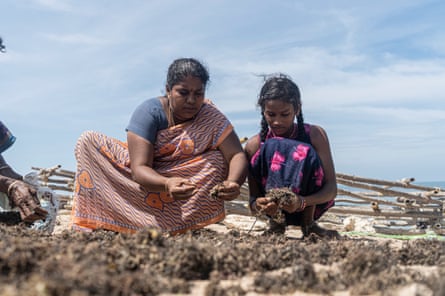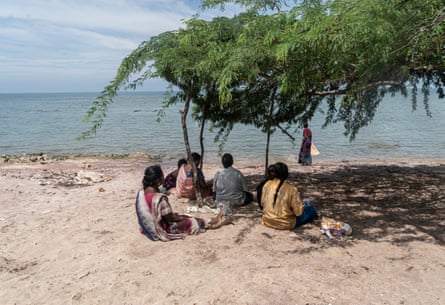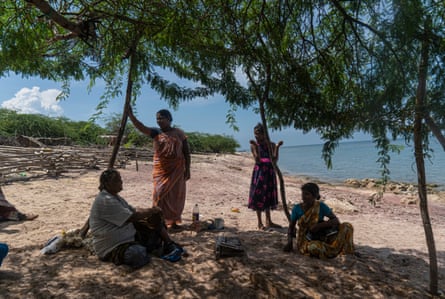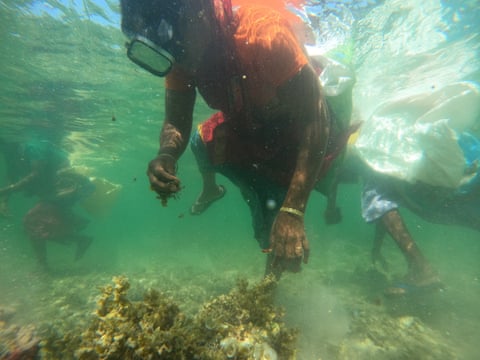With sacks tied around their saris and well-used goggles as their only equipment, the seaweed collectors of India’s south-east coast have been diving in the Gulf of Mannar for decades, passing skills from mother to daughter.
The women spend six hours a day in the sea, diving up to 4 metres (13ft) to harvest the seaweed from sharp rocks, holding their breath as they tuck the fronds into bags tied around their waists.
In Rameswaram, on the Tamil Nadu coast, it is a dying art. More girls are now able to go to school and pursue working lives that are less dependent on the dangerous tides and bruising work.
Sethunambu, who, like most of the women, goes by only one name, thinks she is about 60 now, and has been diving for much of her adult life. “I am in this profession for the past 20 years, and I have encountered the risks along with other women like me,” she says.



The divers face many risks such as unpredictable tides and venomous fish, as well as regular scrapes and bruises
“We tie a sack over our sari, around our waist, and gather the plants that we have scrapped off the rocks with our bruised hands while diving deep into the water.”
The collected seaweed has to be dried before it is sold to traders, who sell it on for use in the food and beauty industries. Under the best conditions of low tides and favourable weather, the most the divers can earn is £120 a month.

The seaweed must be dried out before it can be sold for use in the food and beauty industries
Munishwari lives in Mangadu village, 3km from where she collects the seaweed. Although she followed her mother’s path, and the trade has earned her a living, Munishwari does not want to see the next generation follow her into the tradition.
“I suffer from allergies and itchiness on a daily basis, my hands and feet are bruised, and sometimes I encounter dangerous fish in the water,” she says.
“I have been living in fear with this occupation, although it was the only source that brought some bread to my house. I want my children to move out of this circle and choose education over this. However, I will teach my daughter the art as a backup plan.”


Seaweed harvesters Sethunambu (left), who has been diving for 20 years, and Lavanya
Lavanya, another harvester, is proud of her work. “Our earnings are modest and we face financial constraints due to limited value assigned to our harvests. However, we give our best and make the most out of whatever life offers us. We take pride in whatever we are earning with dignity,” she says.
In the small town of Olaikadu, Suganthi Ravi, 39, lives with her two daughters and a fisher husband. She is one of about 300 local women who harvest marigold seaweed from March to May. Ravi spends the rest of the year selling seaweed products and handcrafts made by her and the other women. A committed environmentalist, she also visits schools to talk to children about the importance of looking after the sea.

Suganthi Ravi and one of her daughters sort seaweed on the beach. Ravi says pollution is affecting the growth of the seaweed
“There is a shrimp farm nearby that has a lot of wastewater, which is being dumped in the sea,” she says. “It affects the seaweed growth, and we do not want such waste to impact our livelihood. It also harms the fish.”
The seaweed divers are facing increasing challenges due of the climate crisis and coastal development. Rising salination levels, extreme weather conditions and changes in nutrient cycling and pest populations are all eating into their earnings. Government regulations to protect marine ecosystems are also bringing new red tape to their work.




The women face a challenging environment: the climate crisis and marine pollution are making it harder to make a living from their trade
Few of the women will mourn the passing of their trade. They all emphasise the risks they face from venomous creatures in the water, and the scrapes, bites and stings that can lead to expensive and painful hospital visits.
For now, though, the women celebrate the financial independence the seaweed brings them. “Although the dangerous habitat and unpredictable tides always pose a threat to our lives, it brings satisfactory wages to our homes,” says Ravi.

Suganthi Ravi teaching one of her daughters at home
